10 permission marketing principles and campaign examples integrating web, email and social media marketing
It is now nearly 15 years since Seth Godin launched his permission marketing mantra. Yet it remains highly relevant - I still recommend newcomers to online marketing download and read his permission marketing principles.
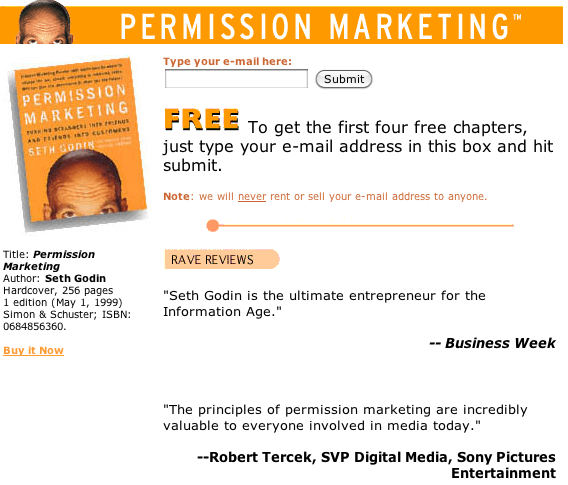
But how does permission marketing apply today? In this post I show examples of how digital marketers today are applying Permission marketing principles to their email marketing and social media marketing activities today.
In his book, Godin explains the principles of using permission marketing both in the offline world and online world, but he doesn't describe in detail how to best achieve permission marketing using web and e-mail.
For each of the core principles of permission marketing, I identify, define and illustrate my principles of ‘e-permission marketing’ which show how web,social, e-mail and offline communications can be best combined to achieve permission marketing online.
Let's start with a great example from the home page of Boticca.com, the designer jewelry brand. You can see they are bold enough to engage their new visitors with a limited offer and the option of joining as a member via Facebook or Email. A great example of an Always-On campaign.
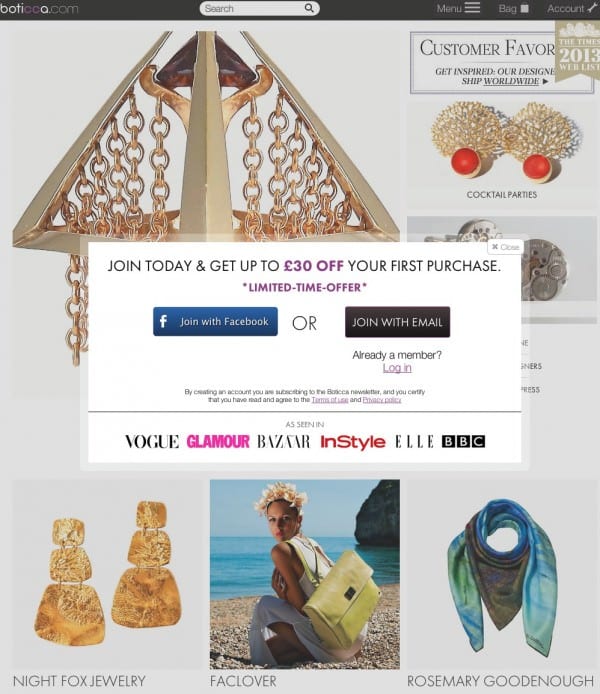
Another modern version of Permission marketing is a Facebook opt-in or Likegate page which is part of an integrated campaign with offline communications to make fans aware of the offer and driving them to the web. Here's a simple example of a Likegate, here's a simple example, promoted through offline communications.
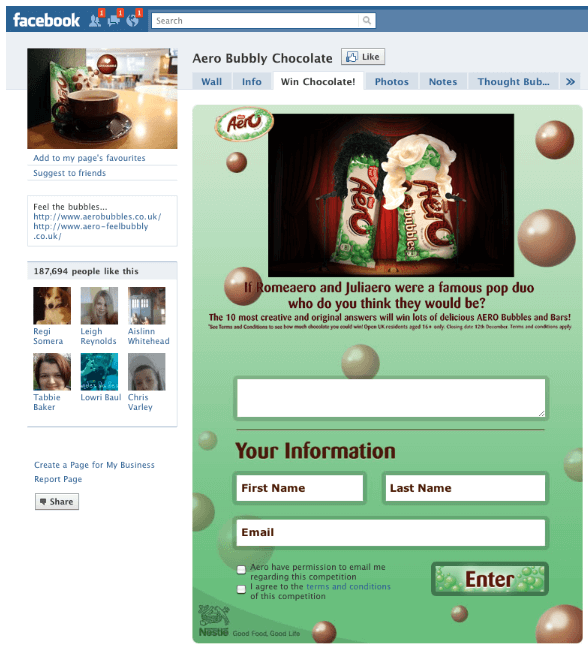
Next, a more sophisticated, fantastic example of a Joined-up 'Share to Win' campaign recommended to me by Melvin Hurley. It is based on a 'Travel Bucket' wish list which customers are encouraged to share through videos and write-ups. Here are the illustrated steps:
Step 1. Promote to existing customers through email
Subject line: Just one week left to enter to win a dream holiday!
The aim is to encourage subscribers to like the company on Facebook and then encourage entries - both which will have a viral effect.
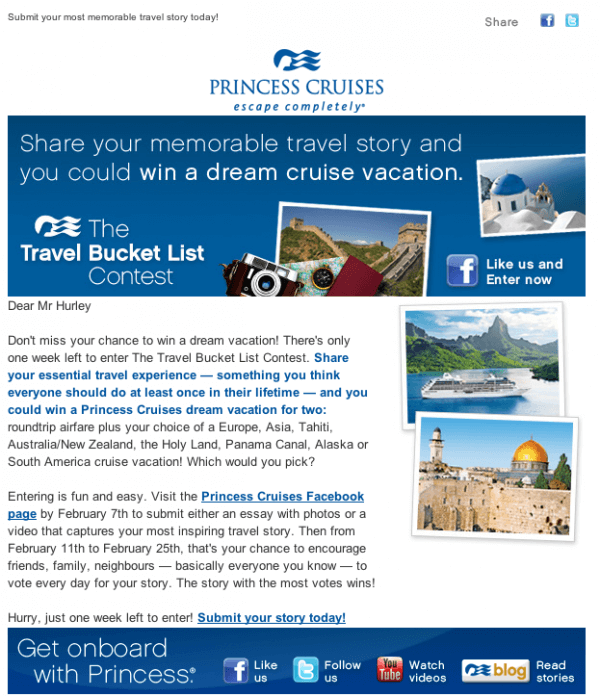
Step 2. Facebook contest tab encourages like
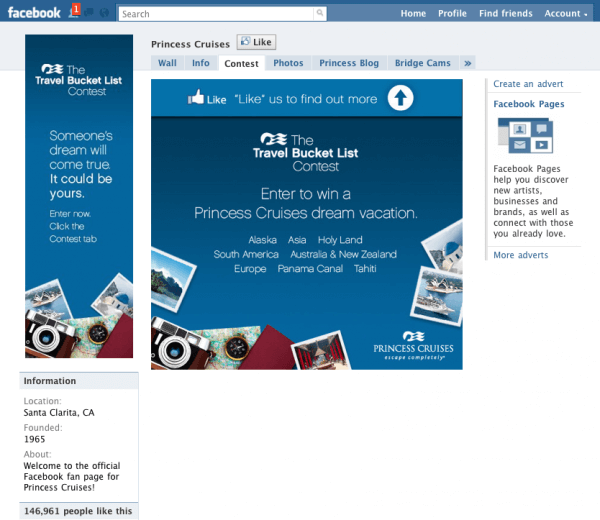
Step 3. Engage through contest tabs to create, share and win
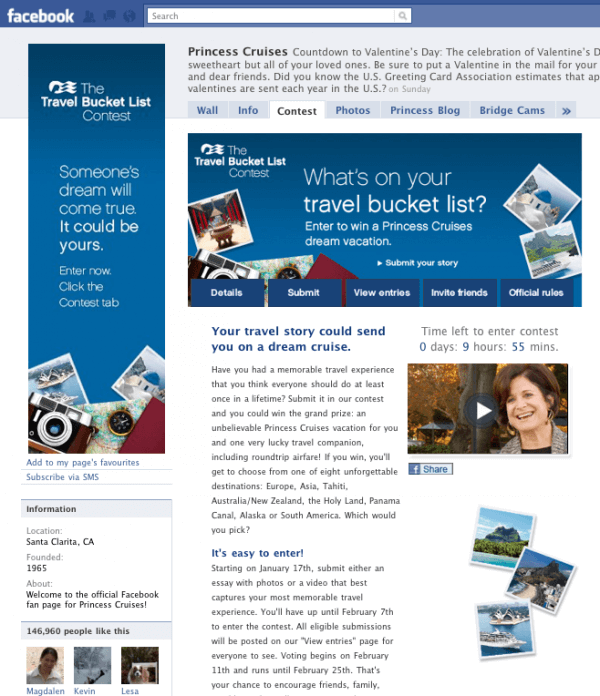
Step 4. Inspire through blog which acts as a campaign hub

I hope that sparks your interest, next the e-permission marketing principles.
E-permission Marketing principle 1 – Reduce interruption marketing.
The permission marketing concept suggests that communications requested by customers have a greater impact and higher response rates than the many unsolicited communications which bombard us each day through print, mail and
TV.
Seth Godin says that permission-based communications are ‘anticipated, personal and relevant’.
But the way email marketing is often carried out today IS interruption marketing - "pray and spray" often describes it well! So the first thing to review is choosing the right email frequency.
Also as many have pointed out, and as Godin recognises, interruption will always be needed for customer acquisition and when starting a dialogue with potential customers in the first place
E-permission Marketing principle 2: ‘Select the best mix of communications tools’
There are many Internet marketing tools that can be used to build awareness in your target audience and prompt for permission to be given.
As the Aero example shows, there is still a big role for offline campaigns to increase awareness of an offer and "drive to web". These days, the destination is often the Facebook page since engagement here is easier.
E-permission Marketing principle 3:‘Think Request Marketing’
Way back in 2002 usability expert Jakob Nielsen argued that permission marketing does not fit with the ethos of the web as a customer-controlled experience (i.e. a pull medium rather than a push medium).
Instead he argued that on the web, it should not be about the company gaining permission, but the customer requesting information. A subtle, but important distinction...
He gives the example of the facility on Amazon where a site visitor can request e-mail notification about future books from an author. Notifications, such as information about new products or new reports requested by the user can also be shown on the web site on future visits in what Nielsen refers to as ‘an information control panel’.
Today we're seeing a trend where there is a benefit in setting your content free from the email opt-in with the viral effect increasing awareness more.
The fantastic PDF summaries by David Meerman Scott on Marketing and PR are a good example of this.
Or at least you should think about not putting all the content behind a subscription barrier - if visitors just see one barrier after another - it's not great.
E-permission Marketing principle 4 – Achieve Opt-in.
The permission in permission marketing was traditionally granted through an individual opting in to communications by proactively agreeing to receive communications.
For email lists, opt-in is usually achieved through the ubiquitous tick box. Since Seth's original book it's a legal requirement enforced by the UK Privacy and Electronic Communications Regulations 2003 and CAN SPAM in the US.
Today, opt-in to receive updates from a brand may be through RSS or network updates on a social network. This is great since it gives customer more choice of communications channels and there is a lot less friction to opt-in
But if you only have a network permission this doesn't give you the opportunity to deliver messages which help build a relationship.
Seth Godin says: ‘Permission Marketers spend as little time and money talking to strangers as they can. Instead, they move as quickly as they can to turn strangers into prospects who choose to "opt-in" to a series of communications.’
These series of communications such as a welcome or reactivation strategy can only be delivered by email now. Maybe this is a service that the social networks could usefully offer?
E-permission Marketing principle 5: ‘Offer selective opt-in to communications’
Although many legitimate marketers are now practicing basic opt-in to an e-newsletter, a more sophisticated form of opt-in is available for effective e-marketing communications.
This is selective opt-in. This simply refers to offering choice to the customer to ensure more relevant communications. This is delivered through a customer preference centre or profile options. It's still relatively rare outside of the big publishers and transactional sites such as retailers since it does need planning and the right technology foundation.
Four of the main options for communications preferences are:
1. Content – Tick boxes for news, products, offers, events.
2. Frequency – weekly, monthly, quarterly, or alerts
3. Channel – E-mail or direct mail
4. Format – Text vs HTML
There are resource implications for tailoring communications, so you will need to consider which give the best benefit. Frequency and format are probably the options that will give the best response for the least effort.
E-permission Marketing principle 6: Create a ‘common customer profile’
Permission marketing involves gaining permission both to communicate with and learn more about customers.
Since we are looking to learn more through time, we need a structured approach to customer data capture.
This can be achieved through a common customer profile – a definition of all the database fields that are relevant to the marketer in order to understand and target the customer with a relevant offering. Many organisations will have created a common customer profile that they use for offline data capture, perhaps through a call-centre, but often-time, if e-marketing is not integrated, the data captured offline will be separate.
Once defined, the common customer profile can then be used as a means of structuring e-permission marketing and refining understanding about the customer. A plan with targets can be created about how to learn more about the customer.
E-permission Marketing principle 7 – Use powerful incentives to gain opt-in and offer a range of incentives or engagement devices
This is an obvious one! Quality incentives are needed to obtain permission.
But one size may not fit all - Seth Godin talks about offering a range of incentives as part of ‘dating the customer’.
Many web sites now have ‘free-win-save’ incentives to encourage opt-in.
Different incentives for different audiences will generate a higher volume of permission, particularly for business-to-business web sites. We can also gauge the characteristics of the respondent by the type of incentives or communications they have requested,without the need to ask them.
Think about a B2B site for a CRM software vendor which offers white-papers to encourage opt-in.
Different whitepapers could be developed for influencers such as junior managers, marketing directors and IT managers who will implement the system. However, without thinking through the incentive options for different audiences, white-papers might exclude the IT managers who are important in the buying process.
E-permission Marketing principle 8: ‘Maximise learning, minimise attrition’
As visitors respond to our incentives, we present them with an online data capture form. This, of course, is our opportunity to understand more about the customer.
There is a balance to strike between too many questions which will help us understand our customer well, but may well put-off subscribers and too few questions which will increase the size of the list, but not allow us to qualify interest and determine characteristics.
Sometimes over half the people who visit a data capture form used to obtain permission may not complete the process. They are put off by the number of questions or concern about their privacy. Although it can be argued that this is a form of qualification, some good prospects may be missed.
E-permission marketers need to work hard to minimise the attrition from these forms through:
Asking the optimal number of questions.
This is a difficult balance to get right since it will vary between audiences. Often, I feel insufficient profiling is done. If the incentive is good enough and/or there is a high-involvement product, then respondents may well be prepared to take the time to give their interests, particularly if it is explained that this will be used to provide tailored communications.
Devising powerful incentives. As we have said, incentives must be available for a range of audiences. And these incentives need to be powerful enough for someone to fill in the form accurately.
Explaining how the customer data will be used. Through explaining that the data collected will be used to improve the information and experience delivered to the customer, customers will understand why the data is being collected.
Reassuring about privacy. Often, the magic words ‘we will not share your data’ at the top of the form will increase response since privacy is a common concern.
Better on the form than hidden away in a privacy statement.
Using multiple forms. Two or three short forms of profile information may be less
daunting than a single long form.
TIMITI.
Test the form until you have the balance right. Think Jim Sterne ’s approach to online marketing to ‘Try It’, ‘Measure It’, ‘Tweak It’ (Sterne, 2002).
These days we have AB and multivariate tools testing to help find works, but they are still not that widely used eventhough for relationship building sites you can say this is the most important page on the site.
Permission Marketing principle 9 – Enable Opt-out.
This is a given… Permission marketing involves making it easy for the recipient of communications to specify that they no longer wish to be in a dialogue. Online, this is the e-mail unsubscribe option.
My view is that we can make it too easy to unsubscribe. It should be easy, sure and should work. But is the one-click unsubscribe always right? I don't think always.
Although an easy form of opt-out is now a legal requirement in many countries, a single click unsubscribe is making it too easy. Instead, wise e-permission marketers use the concept of MyProfile. Instead of unsubscribe, they offer a link to a web form to update a profile, which includes the option to unsubscribe. This will still be legal if the option to unsubscribe is clearly visible within this form.
‘My Profile’ can be tied to the principle of ‘selective opt-in’ – you could call it selective opt-out. If there are a range of choices of communication, then the recipient may decide to change the type or frequency of communications rather than opting-out. For example the person intending to unsubscribe may change from a monthly e-newsletter to a quarterly e-mail or e-mail alerts about product news or promotions only.
Opt-out can also be used for event marketing. Often a marketer will want to run a multi-message campaign to inform and remind recipients about an event. If there is a sequence of say, 4 communications about an event, then the recipient can opt-out to not hear anything further about this event.
Permission Marketing principle 9 – Learn more through time
Seth Godin said we should aim to learn more about the customer through time – this means offering additional incentives to continue the dialogue. This is sometimes referred to as ‘incremental profiling’ which means filling in more of the fields on the common customer profile referred to above.
You should consider the approach of "Watch don’t ask’".
Since one of the difficulties with e-permission marketing is the potential interruption and intrusion caused by asking the customer too many questions via online forms.
The need to ask questions can be reduced through using monitoring of online interactions or responses to better understand the customer needs and generate follow-up communications. Some examples are:
Monitoring click-through to different types of content or offer - The interests of individual list members can be assessed through monitoring what they click through to. Lastminute.com reputedly tailor their newsletters according to content clickthrough. For example, if you click through theatres or city-breaks, then you will receive more of this type of content infuture.
Basing communications on the engagement of individual customers with e-mail communications can be achieved by monitoring trends of opening and click-through by individual customer. These metrics indicate the level of interest of individual customers and we can monitor how these vary through time and use follow-up communications. For example, perhaps a buying signal is suggested by a customer who has not previously responded to e-mails who starts clicking through to the web site more frequently. This could be followed up by a tailored e-mail communication or a phone call.
If a B2B vendor offers information about a new product launch which encourages click through to a landing page then they have two main choices of follow-up. First, the form could contain a question asking about the future buying intentions or whether contact from a sales rep is required. Alternatively, if there is a capability to monitor an individual who has clicked through to a page, then it may be best to use this to prompt a call from an account manager or sales person. The second approach may result in more sales, but of course there is a danger that the customer may react negatively to monitoring of this type and it is arguably not permission marketing.
E-permission Marketing principle 11: ‘Vary online offers through time’
We have said we should not discourage the initial opt-in through asking too many profiling questions and learn more through time. So we should have a plan to capture more profile information through time. We can then also monitor how the status or buying intent of the customer varies through time.
The best approach to this is to develop a structured programme of online offers - still a key part of content strategy.
E-permission marketing principle 12: Create an outbound contact strategy
Online permission marketers need a plan for the number, frequency and type of online
and offline communications and offers. This is a contact strategy.
A good starting point is to review the email metrics. You review opens, returns or response and research customer preferences to help get the offer and frequency right. Then you can work on creating a contact strategy.
The contact strategy should show:
1. Frequency. This defines the minimum frequency (e.g. once per quarter) and maximum frequency (e.g. once per month). Remember that we will often e-mail too infrequently Similarly, it may also be useful to set communications targets such as ‘at least four e-mails per year’
2. Interval. Some companies may seek to set limits on interval, e.g. there must be a gap of at least one week or one month between communications. This may be overtly restrictive and brings us to the next point…
3. Flexibility. It is impossible to create rules to cater for all occasions and some companies have limited opportunities by creating such rules. For example, a rule to limit intervals to greater than one week or month would restrict multi-message campaigns where there a reminder is sent out to boost response.
4. Content and offers. We may want to limit or achieve a certain number of prize draws or information-led offers.
5. Links between e-newsletters and campaign e-mails. Often the link between e-mails and campaign e-mails is missed in communications planning. This can lead to missed opportunities where the e-newsletter could be used to reinforce messages in campaigns. Or sometimes the e-newsletter may be the main vehicle for explaining an offer, but it may get diluted amongst the other items.
6. Links between online communications and offline communications. Again, synergies between online and offline communications may be missed or there may be mixed messages.
7. A control strategy. A mechanism to make sure these guidelines are adhered to is essential. One method is to use a ‘focal point’, or single person who checks all communications for one group of customers before creation or dispatch.
So, these are my 10 principles of E-permission Marketing. I have developed them over the
past few years through working with clients and delegates on e-marketing
workshops from the Chartered Institute of Marketing, Institute of Direct Marketing and Econsultancy. So I would like to acknowledge the discussions with many marketers used to create them, and of course, Seth Godin, for developing such a powerful, practical framework for marketers to apply which has stood the test of Internet time!
Of course these principles have evolved, and will evolve more, so please let me know what you feel is inaccurate or missing.
References
Chaffey, D.
(2003) Total E-mail Marketing. Butterworth Heinemann. Oxford.
Godin, S.
(1999) Permission Marketing. Available online at: www.permission.com.
Nielsen, J.
(2002) Request Marketing. Alertbox, October 15, 2000. www.useit.com/alertbox/20001015.html











